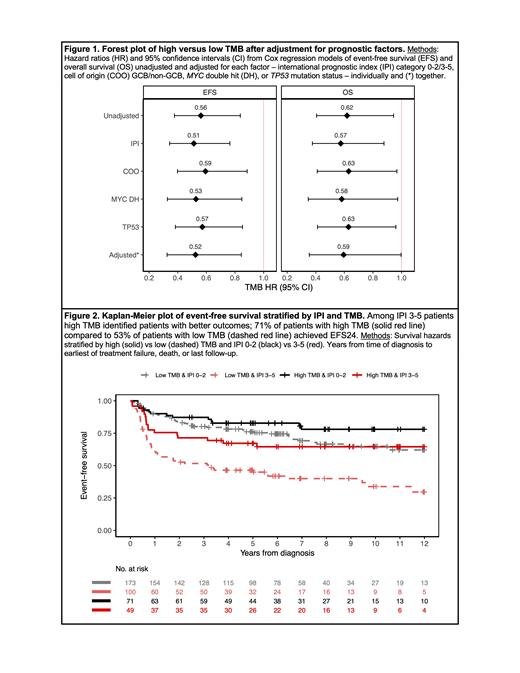Background: Tumor mutational burden (TMB), defined as the number of nonsynonymous mutations per megabase (Mb) in the coding regions of a tumor genome, has been associated with improved response to immune checkpoint blockade treatments and more broadly with overall survival (OS) in many cancers. Limited prior studies have found that TMB is higher in diffuse large B-cell lymphoma (DLBCL) compared to many other cancers. However, only two studies have evaluated TMB and prognosis in newly diagnosed DLBCL patients. The prognostic role of TMB in diffuse large B-cell lymphoma (DLBCL) remains unclear as prior studies have been limited to panel sequencing of cancer genes and/or lacked matched germline-tumor samples for filtering.
Methods: We characterized TMB from whole exome sequencing (WES) in newly diagnosed DLBCL patients with matched diagnostic tumor-normal samples prior to treatment with standard immunochemotherapy (IC). Tumor DNA was extracted from formalin-fixed, paraffin embedded tissue sections and germline DNA from peripheral blood. We evaluated the association between TMB and event-free (EFS) and OS using Cox regression adjusted for the international prognostic index (IPI) and other factors including cell of origin (COO), MYC double hit (DH) with BLC2 or BCL6 by FISH, and TP53 mutation status. EFS and OS were defined as time from diagnosis to earliest of treatment failure (EFS only), death, or last follow-up; EFS at 24 months (EFS24) was also modeled as a marker of early aggressive DLBCL. An optimal high/low TMB cutpoint was determined based on EFS using maximally selected rank statistics; sensitivity analyses used an 20/80 percentile to define the threshold. We also evaluated the association of driver tumor mutational load (driverTML) with EFS and OS, defined as the total number of mutations in 292 DLBCL driver genes.
Results: In the analysis cohort of 394 DLBCL patients, the median age at diagnosis was 65 years (interquartile range: 56-73), 43% were female, 62.2% had IPI 0-2, and 57.4% germinal center B-cell COO. MYC was DH in 7.5% and TP53 was mutated in 16.2% of patients. Through a median follow-up of 7.5 years, there were 141 events and 122 deaths. EFS24 was achieved in 75.1% of the cohort; 5-year EFS was 69% (95% CI 64-74%) and 5-year OS was 75% (95% CI 71-80%). Median TMB in our cohort of DLBCL patients was 3.6 mutations/Mb, which was the fifth highest compared with 32 cancers in The Cancer Genome Atlas. As a continuous variable, increasing TMB (mutation/Mb) was associated with superior EFS (HR=0.89, 95% CI 0.81-0.98) and OS (HR=0.89, 95% CI 0.81-0.99) after adjustment for IPI. Spline analyses confirmed linear associations of TMB with EFS and OS. The optimal modeled cutpoint based on EFS was 4.5 mutations/Mb, with 31% classified as high TMB (>4.5). No significant ( P >.05) differences were observed between high and low TMB patients with clinical (i.e., age, sex, IPI category) or molecular (cell of origin, MYC DH, TP53 mutated) factors. In Cox regression, high-TMB was significantly protective for EFS and for OS compared to low-TMB after adjustment for each clinical factor ( Figure 1), with simultaneous adjustment for all these factors associated with superior EFS (HR=0.52, 95% CI 0.33-0.84) and OS (HR=0.59, 95% CI 0.36-1.00). TMB (high/low) combined with IPI (0-2, 3-5) was significantly ( P =.001) associated with EFS in Kaplan-Meier analysis ( Figure 2). Among patients with IPI 3-5, high TMB was significantly associated with superior EFS (HR=0.47, 95% CI 0.27-0.81) and OS (HR=0.57, 95% CI 0.33-0.99). Among patients with IPI 0-2, we also observed longer EFS (HR=0.62, 95% CI 0.34-1.11) and OS (HR=0.62, 95% CI 0.32-1.20) in high TMB patients, although the associations were not statistically significant ( P >.05). In sensitivity analyses, a 20/80 percentile TMB threshold found similar results for EFS (HR=0.64, 95% CI 0.41-1.03) and OS (HR=0.69, 95% CI 0.42-1.12) as in our main analyses. TMB and driverTML were significantly correlated ( R=0.65, P <10 -16) and we found similar effect sizes for EFS (HR=0.45, 95% CI 0.22-0.91) and OS (HR=0.55, 95% 0.27-1.13) as in our main analyses.
Conclusions: In a large and well-defined cohort of IC treated DLBCL patients, we found DLBCL patients with higher TMB had superior EFS and OS after adjustment for other clinical and molecular prognostic factors, and the prognostic association for TMB was robust to threshold and gene set.
Disclosures
Wenzl:Bristol Myers Squibb: Current Employment. Rimsza:Roche: Other: Consulting; NanoString: Other: Licensed intellectual property. Nowakowski:Seagen: Consultancy; F Hoffmann-La Roche Limited: Consultancy; Genentech: Consultancy; Incyte: Consultancy; Zai Lab Limited: Consultancy; MEI Pharma: Consultancy; Karyopharm Therapeutics: Consultancy, Membership on an entity's Board of Directors or advisory committees; Bristol-Myers Squibb: Consultancy, Membership on an entity's Board of Directors or advisory committees, Research Funding; Fate Therapeutics: Consultancy, Membership on an entity's Board of Directors or advisory committees; Kymera Therapeutics: Consultancy; Ryvu Therapeutics: Consultancy, Membership on an entity's Board of Directors or advisory committees; ADC Therapeutics: Consultancy; TG Therapeutics: Consultancy; Abbvie: Consultancy; Celgene Corporation: Consultancy; Curis: Consultancy; Blueprint Medicines: Consultancy; Kite Pharma: Consultancy; Bantam Pharmaceutical LLC: Consultancy; Debiopharm: Consultancy; Selvita Inc: Consultancy; MorphoSys: Consultancy, Membership on an entity's Board of Directors or advisory committees, Research Funding. Habermann:sorrento: Research Funding; BMS: Research Funding; Genentech: Research Funding. Stong:Bristol Myers Squibb: Current Employment, Current equity holder in publicly-traded company. Huang:Bristol Myers Squibb: Current Employment, Current equity holder in publicly-traded company. Gandhi:Bristol Myers Squibb: Current Employment, Current equity holder in publicly-traded company. Novak:Bristol Myers Squibb: Research Funding. Cerhan:NanoString: Research Funding; BMS: Membership on an entity's Board of Directors or advisory committees, Research Funding; Genmab: Research Funding; Protagonist: Other: Safety Monitoring Committee; Genentech: Research Funding.


This feature is available to Subscribers Only
Sign In or Create an Account Close Modal